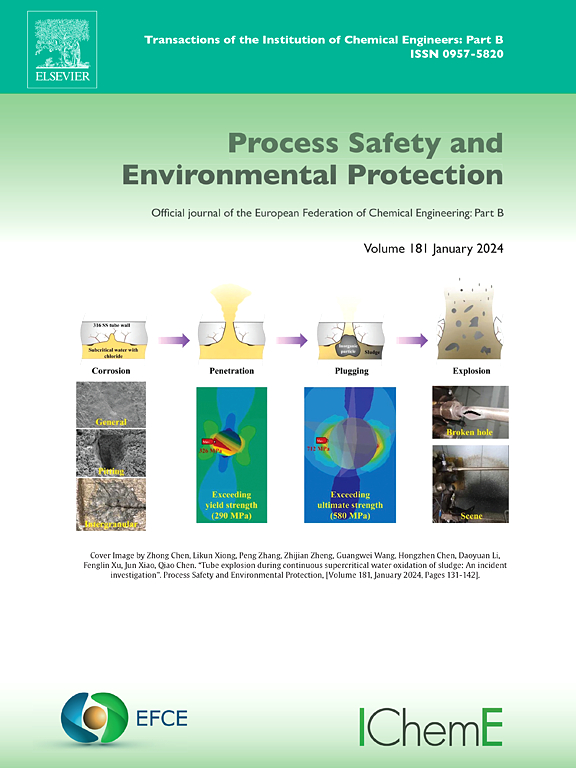DMFC在多联产能源系统中的创新集成,以增强可再生燃料和电力输出
IF 6.9
2区 环境科学与生态学
Q1 ENGINEERING, CHEMICAL
引用次数: 0
摘要
为了利用包括风能和生物质能在内的可再生资源,目前的研究重点是集成质子交换膜电解槽(PEME)、固体氧化物燃料电池(SOFC)、直接甲醇燃料电池(DMFC)以及先进的沼气、甲烷和甲醇生产装置的创新多代能源系统。该系统旨在生产电力、氢气、甲烷和甲醇,同时解决可持续能源生产和温室气体减排方面的挑战。热力学模型评估了系统在不同运行条件下的能源效率和性能。PEME装置高效地生产氢气,用于合成甲烷(SNG)和甲醇。SOFC和DMFC装置分别利用甲烷和甲醇作为燃料发电。关键参数,如电流密度,入口温度和甲醇浓度进行优化,以最大限度地提高效率和最小化能量损失。结果表明,在理想工况下,组合系统的SOFC和DMFC的峰值能效分别达到41.27 %和20.41 %。可再生风能和生物质能资源的结合大大减少了对化石燃料的依赖,有助于大幅度减少二氧化碳的排放。经济分析表明,该系统具有成本效益,根据运行参数的不同,总产品单位成本在27.16美元/GJ至28.41美元/GJ之间。这种综合能源系统展示了一种可持续能源生产的实用方法,可以灵活地生产多种燃料和电力输出,同时减少对环境的影响。研究结果为未来可再生多发电系统的开发和优化提供了一个框架,支持全球能源转型目标和碳中和目标。本文章由计算机程序翻译,如有差异,请以英文原文为准。
Innovative integration of DMFC in polygeneration energy systems for enhanced renewable fuel and power outputs
To leverage renewable resources, including wind energy and biomass, the present research focused on an innovative multi-generation energy system integrating Proton Exchange Membrane Electrolyzers (PEME), Solid Oxide Fuel Cells (SOFC), Direct Methanol Fuel Cells (DMFC), and advanced biogas, methane, and methanol production units. This system aims to produce electricity, hydrogen, methane, and methanol while addressing challenges in sustainable energy generation and greenhouse gas emissions reduction. A thermodynamic model evaluates the system’s energy efficiency and performance under varying operating conditions. The PEME unit efficiently produces hydrogen, which is utilized in the synthesis of methane (SNG) and methanol. The SOFC and DMFC units generate electrical power while utilizing methane and methanol as fuels, respectively. Key parameters such as current density, inlet temperature, and methanol concentration are optimized to maximize efficiency and minimize energy losses. Results indicate that the combined system achieves peak energy efficiencies of 41.27 % for SOFC and 20.41 % for DMFC under ideal operating conditions. The integration of renewable wind and biomass resources significantly reduces reliance on fossil fuels, contributing to a substantial decrease in CO2 emissions. Economic analysis reveals that the system is cost-effective, with total product unit costs ranging between 27.16 $/GJ and 28.41 $/GJ depending on operating parameters. This comprehensive energy system demonstrates a practical approach to sustainable energy generation, with the flexibility to produce multiple fuels and power outputs while reducing environmental impacts. The findings provide a framework for future development and optimization of renewable-based multi-generation systems, supporting global energy transition goals and carbon neutrality objectives.
求助全文
通过发布文献求助,成功后即可免费获取论文全文。
去求助
来源期刊

Process Safety and Environmental Protection
环境科学-工程:化工
CiteScore
11.40
自引率
15.40%
发文量
929
审稿时长
8.0 months
期刊介绍:
The Process Safety and Environmental Protection (PSEP) journal is a leading international publication that focuses on the publication of high-quality, original research papers in the field of engineering, specifically those related to the safety of industrial processes and environmental protection. The journal encourages submissions that present new developments in safety and environmental aspects, particularly those that show how research findings can be applied in process engineering design and practice.
PSEP is particularly interested in research that brings fresh perspectives to established engineering principles, identifies unsolved problems, or suggests directions for future research. The journal also values contributions that push the boundaries of traditional engineering and welcomes multidisciplinary papers.
PSEP's articles are abstracted and indexed by a range of databases and services, which helps to ensure that the journal's research is accessible and recognized in the academic and professional communities. These databases include ANTE, Chemical Abstracts, Chemical Hazards in Industry, Current Contents, Elsevier Engineering Information database, Pascal Francis, Web of Science, Scopus, Engineering Information Database EnCompass LIT (Elsevier), and INSPEC. This wide coverage facilitates the dissemination of the journal's content to a global audience interested in process safety and environmental engineering.
 求助内容:
求助内容: 应助结果提醒方式:
应助结果提醒方式:


